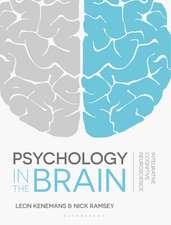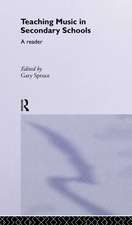Exploring Cognition: Damaged Brains and Neural Networks: Readings in Cognitive Neuropsychology and Connectionist Modelling
Editat de Gillian Cohen, Robert A. Johnstone, Kim Plunketten Limba Engleză Hardback – 28 sep 2000
In this reader key articles by leading international researchers are combined with linking commentaries that provide a context, highlight the conceptual themes and evaluate the evidence. Carefully selected to include hotly debated topics, the papers cover, among others, the controversies surrounding explanations for category specificity in object recognition and for covert recognition of faces and words; the mechanisms underlying the use of regular and irregular past tenses; and the reading of regularly and irregularly spelled words. The challenges posed by connectionist models to assumptions about the nature of dissociations, the need for symbolic rule-based operations in language processing and the modularity and localisation of processes are assessed.
Exploring Cognition: Damaged Brains and Neural Networks will be of interest to advanced undergraduates, postgraduates and researchers in cognitive neuropsychology and cognitive neuroscience.
| Toate formatele și edițiile | Preț | Express |
|---|---|---|
| Paperback (1) | 223.09 lei 6-8 săpt. | |
| Taylor & Francis – 23 mai 2002 | 223.09 lei 6-8 săpt. | |
| Hardback (1) | 507.69 lei 6-8 săpt. | |
| Taylor & Francis – 28 sep 2000 | 507.69 lei 6-8 săpt. |
Preț: 507.69 lei
Preț vechi: 671.92 lei
-24% Nou
Puncte Express: 762
Preț estimativ în valută:
97.15€ • 101.23$ • 80.44£
97.15€ • 101.23$ • 80.44£
Carte tipărită la comandă
Livrare economică 03-17 aprilie
Preluare comenzi: 021 569.72.76
Specificații
ISBN-13: 9781841692173
ISBN-10: 1841692174
Pagini: 480
Dimensiuni: 156 x 234 x 28 mm
Greutate: 1.05 kg
Ediția:1
Editura: Taylor & Francis
Colecția Psychology Press
Locul publicării:Oxford, United Kingdom
ISBN-10: 1841692174
Pagini: 480
Dimensiuni: 156 x 234 x 28 mm
Greutate: 1.05 kg
Ediția:1
Editura: Taylor & Francis
Colecția Psychology Press
Locul publicării:Oxford, United Kingdom
Public țintă
Postgraduate and UndergraduateCuprins
R.A. Johnston, N.R. Braisby, Introduction. SECTION I. R.A. Johnston, Studies in Visual Recognition. Part 1. R.A. Johnston, Object Recognition: Opening Boxes. E.M.E. Forde, G.W. Humphreys, Category-specific Recognition Impairments: A Review of Important Case Studies and Influential Theories. M.J. Farah, J.L. McClelland, A Computational Model of Semantic Memory Impairment: Modality Specificity and Emergent Category Specificity. J.T. Devlin, L.M. Gonnerman, E.S. Andersen, M.S. Seidenberg, Category-specific Semantic Deficits in Focal and Widespread Brain Damage: A Computational Account. Part 2. R.A. Johnston, Face Recognition: Mapping Routes. J.E. McNeil, E.K. Warrington, Prosopagnosia: A Face-Specific Disorder. A.W. Young, D. Hellawell, E.H.F. De Haan, Cross-domain Semantic Priming in Normal Subjects and a Prosopagnosic Patient. A.M. Burton, A.W. Young, V. Bruce, R.A. Johnston, A.W. Ellis, Understanding Covert Recognition. M.J. Farah, R.C. O'Reilly, S.P. Vecera, Dissociated Overt and Covert Recognition as an Emergent Property of a Lesioned Neural Network. A.M. Burton, A.W. Young, Simulation and Explanation: Some Harmony and Some Discord. SECTION II. G. Cohen, Studies in Language Processes. Part 3. K. Plunkett, G. Cohen, Speech Production: Rules and Rehabilitation. V.A. Marchman, Constraints on Plasticity in a Connectionist Model of the English Past Tense. W. Marslen-Wilson, L.K. Tyler, Rules, Representations, and the English Past Tense. P. Juola, K. Plunkett, Why Double Dissociations Don't Mean Much. M. Martin, E.M. Saffran, G.S. Dell, Recovery in Deep Dysphasia: Evidence for a Relation Between Auditory-verbal STM Capacity and Lexical Errors in Repetition. Part 4. P. Naish, Reading: Modelling the Deficits. M. Coltheart, B. Curtis, P. Atkins, M. Haller, Models of Reading Aloud: Dual-route and Parallel-distributed-processing Approaches. G.E. Hinton, D.C. Plaut, T. Shallice, Simulating Brain Damage. K. Mayall, G.W. Humphreys, Covert Recognition in a Connectionist Model of Pure Alexia. G. Cohen, Overview. Glossary. Bibliography.
Notă biografică
Gillan Cohen was formerly Professor of Psychology at the Open University where she produces courses in cognitive psychology. Her research has focused on ageing, naming faces and memory.
Robert Johnston is Senior Lecturer in Psychology at Birmingham University. He has researched and published extensively on models of face recognition and object recogntion, including both clinical and computational approaches.
Kim Plunkett is Professor of Cognitive Neuropscience at the University of Oxford. His main research interest is in connectionist modelling.
Robert Johnston is Senior Lecturer in Psychology at Birmingham University. He has researched and published extensively on models of face recognition and object recogntion, including both clinical and computational approaches.
Kim Plunkett is Professor of Cognitive Neuropscience at the University of Oxford. His main research interest is in connectionist modelling.
Recenzii
In depth chapters - some reprinted articles - deal with many facets of visual recognition, and such specialized language topics as some vagaries of English from a neurocognitive viewpoint, and why double dissociation may not be the high road to fractionating functions. - Journal of the International Neuropsychological Society
Descriere
Analyses the contribution made by cognitve neuropsychology and connectionist modelling to theoretical explanations of cognitive processes. Selected to present some of the most hotly debated topics in the field today.














